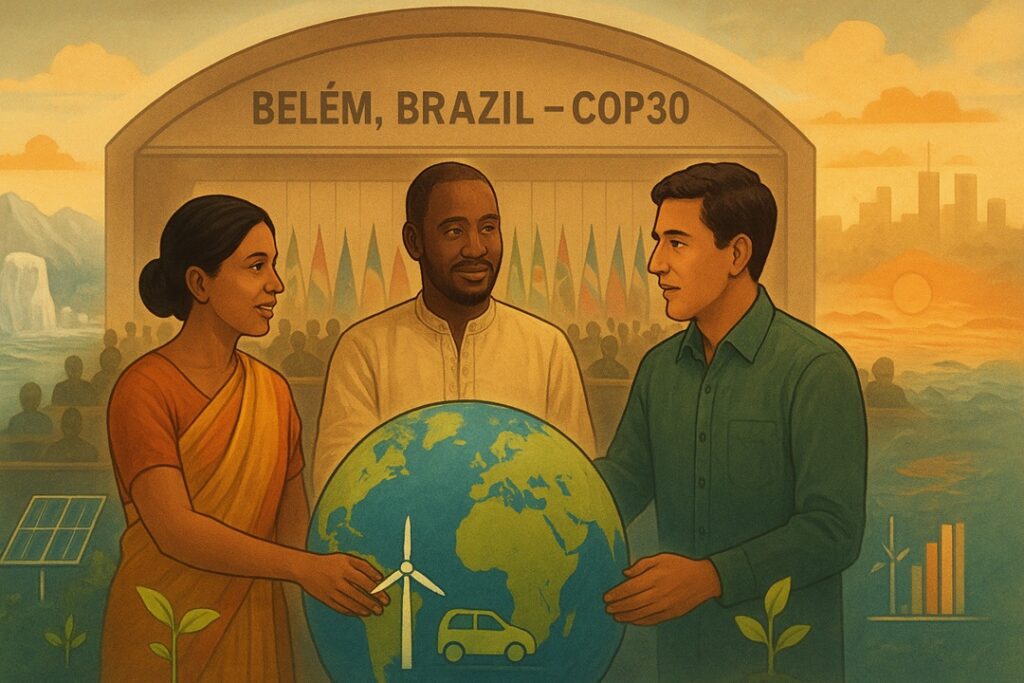COP30 and the Global South: Strengthening Regional Cooperation for Climate Resilience

Context
COP30 is being held in Belém, Brazil, from 10 to 21 November 2025. It is the 30th annual meeting of the Parties to the UNFCCC, which serves as the parent treaty of the 2015 Paris Agreement. The conference aims to assess the implementation of climate commitments, accelerate global action to limit warming to 1.5°C, and ensure that climate finance and technology reach developing and vulnerable nations. For South Asia, the conference offers an opportunity to voice collective concerns, highlight regional vulnerabilities, and strengthen calls for equitable climate finance and technology transfer.
Meaning and Role of COP30
The Conference of the Parties (COP) is the primary global decision-making forum on climate change under the UNFCCC. It brings together almost every country to negotiate actions aimed at mitigating climate change, adapting to its effects, and achieving net-zero emissions by 2050. COP30 continues this mission, focusing on turning past pledges into concrete implementation strategies. Participants include world leaders, negotiators, scientists, civil society members, and representatives of youth and indigenous groups.
Implementation Challenges
A key concern for South Asia lies in the gap between commitments and delivery. Many countries are falling short in implementing their Nationally Determined Contributions (NDCs). According to the Council on Energy, Environment and Water (CEEW), only 65 countries have submitted enhanced NDCs, and just 5 percent of 203 global initiatives launched since 2015 have met their goals. This highlights the need for stronger governance, accountability, and transparent reporting mechanisms to ensure timely progress.
Need for Regional Cooperation
Regional cooperation is essential for South Asia to amplify its voice and pool resources for collective climate action. Platforms such as the G20, BIMSTEC, and BRICS can serve as instruments to align regional priorities, share knowledge, and scale up sustainable technologies. Successful models like India’s Coalition for Disaster Resilient Infrastructure (CDRI) and Nepal’s Sagarmatha Sambaad demonstrate how collaboration can enhance both national and regional resilience.
Climate Vulnerabilities in South Asia
South Asia faces acute climate threats, including extreme heat, floods, droughts, and sea-level rise. The Asian Development Bank projects that days with temperatures above 35°C could double by 2100. Nepal faces glacial lake outburst floods, the Maldives faces coastal submergence, India experiences frequent heatwaves, and Sri Lanka struggles with emerging drylands and water stress. These diverse challenges require inclusive governance that involves sub-national governments, local communities, and women in decision-making.
Building Trust and Accountability
Past experiences of delayed financing and unfulfilled promises by developed countries have eroded trust in the global climate process. Many developed nations are not on track to meet their 2030 NDC targets. To rebuild confidence, developed countries must honor existing pledges, set ambitious emission targets aligned with the 1.5°C goal, and ensure timely financial and technological support to developing countries.
Climate Finance Priorities
South Asia’s climate action depends heavily on access to predictable, adequate, and equitable finance. Climate finance should be sustainable, fairly distributed, accessible with low transaction costs, and largely grant-based to avoid debt burdens. The Baku to Belém Roadmap must clearly define who will contribute, how much, and by when. Dedicated regional allocations from funds like the Green Climate Fund and the Loss and Damage Fund are crucial. Establishing a South Asian Resilience Finance Facility could help mobilize resources for adaptation and nature-based solutions.
Role of Non-State Actors
Non-state actors play a critical role in enhancing ambition and accountability. The private sector can unlock green investments, sub-national governments can align local action with national targets, and civil society can monitor progress and build capacity. Youth, academic institutions, and traditional knowledge holders can contribute innovation, awareness, and culturally rooted solutions, thereby enriching regional climate governance.
Technology and Innovation
Most South Asian nations remain excluded from international technology flows. Bridging this gap is essential for accelerating low-carbon transitions. Emerging technologies such as artificial intelligence, big data, digital public infrastructure, blockchain, and remote sensing can improve data sharing, transparency, and efficiency in climate action. Strengthening digital cooperation within the region can help overcome resource and capacity constraints.
Conclusion
At COP30, the emphasis must shift from pledges to performance. The future of global climate governance depends on three pillars: mutual clarity of responsibilities, mutual cooperation among nations, and mutual implementation of commitments. For South Asia, the conference offers both a challenge and an opportunity—to lead through regional solidarity, innovative partnerships, and inclusive governance. By turning promises into action, the region can reinforce trust in multilateralism and contribute decisively to global climate stability.
Source : The Hindu
